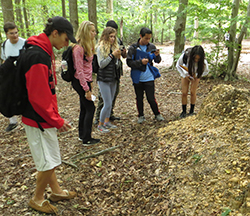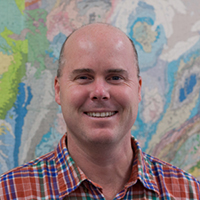Once and Future Planet
How did life begin and evolve on Earth?
 Explore ways in which the emergence and diversification of life has shaped our Earth and vice versa. Frame and explore how we learn about our world and other worlds, and how humans might affect the future of this planet. As a part of this community you will engage in primary research – field work, laboratory analyses, writing – to learn about the natural world and scientific method.
Explore ways in which the emergence and diversification of life has shaped our Earth and vice versa. Frame and explore how we learn about our world and other worlds, and how humans might affect the future of this planet. As a part of this community you will engage in primary research – field work, laboratory analyses, writing – to learn about the natural world and scientific method.
You can expect to:
- Explore the natural world through field excursions on-campus and to the Smithsonian Natural History Museum.
- Conduct a primary research project that collects new data and analyzes it as a community.
- Learn how the environment and life have evolved together over time.
- Work in teams to research and present on the exploration of Mars, Earth, and life.
Community Course
GEOL124: Evolution of Life and Environment on Planet Earth. Topics covered will begin with the Big Bang and the search for life’s origins. You will then explore how life and environment evolved through Earth’s history, and what that means for future interactions. As part of this course, you will conduct on a primary, community research project and develop skills in analysis, hypothesis testing, and scientific reporting. (3 credit course, fulfills General Education requirements of I-Series and Natural Sciences).
View a sample syllabus for GEOL124.
Instructor
 James Farquhar is a professor in the Department of Geology and the Earth System Science Interdisciplinary Center who works at the interface between chemistry, biology, and geology. He has been a faculty member at the University of Maryland since 2001 and is best known for research that tracks the evolution of the atmosphere through geologic time and its connections to the appearance of photosynthetic oxygen 2.4 billion years ago. Prof. Farquhar is now spearheading a large project to study methane in today’s environment and its chemical and biological cycling. This research and this facility form part of the backdrop for Carillon Communities GEOL124.
James Farquhar is a professor in the Department of Geology and the Earth System Science Interdisciplinary Center who works at the interface between chemistry, biology, and geology. He has been a faculty member at the University of Maryland since 2001 and is best known for research that tracks the evolution of the atmosphere through geologic time and its connections to the appearance of photosynthetic oxygen 2.4 billion years ago. Prof. Farquhar is now spearheading a large project to study methane in today’s environment and its chemical and biological cycling. This research and this facility form part of the backdrop for Carillon Communities GEOL124.